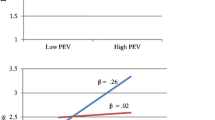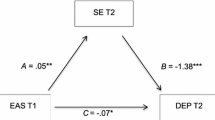Abstract
The present study provided a cross-sectional examination of associations among adverse life events, depressive symptoms, and delinquency in a community sample of 123 early adolescent boys and girls. We also examined whether depressive cognitions, including hopelessness, differentially mediated the relations between exposure to adverse events and delinquent behaviors. Depressive cognitions, especially lack of future orientation, were associated with delinquent behaviors and partially mediated the relationship between adverse events and delinquent behaviors. Findings highlight the importance of future orientation among adversity-exposed youth, and suggest that interventions for trauma should focus on instilling optimism and hope as a means of reducing risk for negative outcomes, including delinquency.
Similar content being viewed by others
References
Abramson, L. Y., Metalsky, G. I., & Alloy, L. B. (1989). Hopelessness depression: A theory-based subtype of depression. Psychological Review, 96, 358–372.
Agnew, R. (2001). Building on the foundation of general strain theory: Specifying the types of strain most likely to lead to crime and delinquency. Journal of Research in Crime and Delinquency, 38, 319–465.
Aiken, L. S., & West, S. G. (1991). Multiple regression: Testing and interpreting interactions. Thousand Oaks, CA: Sage.
Allwood, M. A. & Bell, D. J. (2008). A preliminary examination of emotional and cognitive mediators in the relations between violence exposure and violent behaviors in youth. Journal of Community Psychology, 36, 989–1007.
Allwood, M. A., Bell, D., & Husain, S. A. (2002). Children’s trauma and adjustment reactions to violent and nonviolent war experiences. Journal of the American Academy of Child and Adolescent Psychiatry, 41, 450–457.
Allwood, M. A., Dyl, J., Hunt, J. I., & Spirito, A. (2008). Comorbidity and service utilization among psychiatrically hospitalized adolescents and posttraumatic stress disorder. Journal of Psychological Trauma, 7, 104–121.
American Psychiatric Association. (2000). Diagnostic and statistical manual of mental disorders (4th ed., text revision). Washington, DC: Author.
Baron, R. M., & Kenny, D. A. (1986). The mediator-moderator variable distinction in social psychological research: Conceptual, strategic, and statistical considerations. Journal of Personality and Social Psychology, 51, 1173–1182.
Beyers, J., & Loeber, R. (2003). Untangling developmental relations between depressed mood & delinquency in male adolescents. Journal of Abnormal Child Psychology, 31, 247–266.
Bolland, J. M. (2003). Hopelessness and risk behaviour among adolescents living in high-poverty inner-city neighborhoods. Journal of Adolescence, 26, 145–158.
Deblinger, E., Mannarino, A., Cohen, J., & Steer, R. (2006). A follow-up study of a multisite, randomized, controlled trial for children with sexual abuse-related PTSD symptoms. Journal of the American Academy of Child & Adolescent Psychiatry, 45, 1474–1484.
Dowdney, L. (2000). Annotation: Childhood bereavement following parental death. Journal of Child Psychology and Psychiatry and Allied Disciplines, 41, 819–830.
Durbin, C., & Shafir, D. (2008). Emotion regulation and risk for depression. In J. R. Z. Abela & H. L. Hankin (Eds.), Handbook of depression in children and adolescents (pp. 149–176). New York: Guilford.
Eitle, D., Gunkel, S., & Van Gundy, K. (2004). Cumulative exposure to stressful life events and male gang membership. Journal of Criminal Justice, 32, 95–111.
Eitle, D., & Turner, R. J. (2002). Exposure to community violence and young adult crime: The effects of witnessing violence, traumatic victimization, and other stressful life events. Journal of Research in Crime and Delinquency, 39, 214–237.
Elliot, D. S., Huizinga, D., & Ageton, S. S. (1985). Explaining delinquency and drug use. Thousand Oaks, CA: Sage.
Esposito, C. G., & Clum, G. A. (1999). Specificity of depressive symptoms and suicidality in a juvenile delinquent population. Psychopathology & Behavioral Assessment, 21, 171–182.
Evans, L. G., & Oehler-Stinnett, J. (2006). Structure and prevalence of PTSD symptomology in children who have experienced a severe tornado. Psychology in the Schools, 43, 283–295.
Fazel, S., Doll, G., & Langstrom, N. (2008). Mental disorders among adolescents in juvenile detention and correctional facilities: A systematic review and meta-regression analysis of 25 surveys. Journal of the American Academy of Child and Adolescent Psychiatry, 47, 1010–1019.
Felson, R. B. (1992). Kick’ em when they’re down: Explanations of the relationship between stress and interpersonal aggression and violence. The Sociological Quarterly, 33, 1–16.
Hastings, T. L., & Kelly, M. L. (1997). Development and validation of the screen for adolescent violence exposure (SAVE). Journal of Abnormal Child Psychology, 25, 511–520.
Huizinga, D. & Elliott, D. S. (1986). Reassessing the reliability and validity of self-report delinquency measures. Journal of Quantitative Criminology, 2, 293–327.
Jenkins, E. J., Wang, E., & Turner, L. (2009). Traumatic events involving friends and family members in a sample of African American early adolescents. American Journal of Orthopsychiatry, 79, 398–406.
Juby, H., & Farrington, D. P. (2001). Disentangling the link between disrupted families and delinquency. British Journal of Criminology, 41, 22–40.
Kazdin, A. E., Rodgers, A., & Colbus, D. (1986). The Hopelessness Scale for Children: Psychometric characteristics and concurrent validity. Journal of Consulting and Clinical Psychology, 54, 241–245.
Key, J. D., Brown, R. T., Marsh, L. D., Spratt, E. G., & Recknor, J. C. (2001). Depressive symptoms in adolescents with a chronic illness. Children’s Health Care, 30, 283–292.
Kilpatrick, D. G., Ruggiero, K. J., Acierno, R., Saunders, B. E., Resnick, H. S., & Best, C. L. (2003). Violence and risk of PTSD, major depression, substance abuse/dependence, and comorbidity: Results from the National Survey of Adolescents. Journal of Consulting and Clinical Psychology, 71, 692–700.
Kovacs, M. (1992). Children’s Depression Inventory (CDI) manual. Los Angeles: Western Psychological Services/Multi-Health Systems, Inc.
Kraaij, V., Garnefski, N., Jan de Wilde, E., Dijkstra, A., Gebhardt, W., Maes, S., et al. (2003). Negative life events and depressive symptoms in late adolescence: Bonding and cognitive coping as vulnerability factors? Journal of Youth & Adolescence, 32, 185–193.
Lipschitz, D. S., Winegar, R. K., Hartnick, E., Foote, B., & Southwick, S. M. (1999). Posttraumatic stress disorder in hospitalized adolescents: Psychiatric comorbidity and clinical correlates. Journal of the American Academy of Child and Adolescent Psychiatry, 38, 385–392.
Loeber, R., Russo, M. F., Stouthamer-Loeber, M., & Lahey, B. B. (1994). Internalizing problems and their relation to the development of disruptive behaviors in adolescence. Journal of Research on Adolescence, 4, 615–637.
Lorian, R. S., & Saltzman, W. (1993). Children exposed to community violence: Following a path from concern to research action. Psychiatry, 56, 55–65.
Masten, A. S. (2001). Ordinary magic: Resilience processes in development. American Psychologist, 56, 227–238.
Mazza, J. J. (2000). The relationship between posttraumatic stress symptomology and suicidal behavior in school-based adolescents. Suicide & Life-Threatening Behavior, 30, 91–103.
Pynoos, R. S., Rodriguez, N., Steinberg, A., Stuber, M., & Frederick, C. (1998). UCLA PTSD Index for DSM-IV. Los Angeles: Authors.
Rosenthal, B. S. (2000). Exposure to community violence in adolescence: Trauma symptoms. Adolescence, 35, 271–284.
Saxe, G. N., Ellis, B. H. & Kaplow, J. (2006). Collaborative care for traumatized children and teens: A Trauma Systems Therapy approach. New York: Guilford.
U.S. Department of Agriculture, Food and Nutrition Service. (2003, July 8). National school lunch, special milk, and school breakfast programs; National average payments/maximum reimbursement rates. Federal Register, 68(130). Retrieved from http://www.fns.usdu.gov/cnd/governance/notices/naps/NAPs03-04.pdf
Vermeiren, R. (2003). Psychopathology and delinquency in adolescents: A descriptive and developmental perspective. Clinical Psychology Review, 23, 277–318.
Weierich, M. R., & Nock, M. K. (2008). Posttraumatic stress symptoms mediate the relation between childhood sexual abuse and nonsuicidal self-injury. Journal of Consulting and Clinical Psychology, 76, 39–44.
Weis, R., & Ash, S. E. (2009). Changes in adolescent and parent hopefulness in psychotherapy: Effects on adolescent outcomes as evaluated by adolescents, parents, and therapists. The Journal of Positive Psychology, 4, 356–364.
Author information
Authors and Affiliations
Corresponding author
Rights and permissions
About this article
Cite this article
Allwood, M.A., Baetz, C., DeMarco, S. et al. Depressive Symptoms, Including Lack of Future Orientation, as Mediators in the Relationship between Adverse Life Events and Delinquent Behaviors. Journ Child Adol Trauma 5, 114–128 (2012). https://doi.org/10.1080/19361521.2012.671795
Received:
Revised:
Accepted:
Published:
Issue Date:
DOI: https://doi.org/10.1080/19361521.2012.671795




